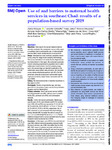2022-03-07Zeitschriftenartikel
Use of and barriers to maternal health services in southeast Chad: results of a population-based survey 2019
Marquis, Adine
O’Keeffe, Jennifer
Jafari, Yalda
Mulanda, Winston
Martin, Antonio Isidro Carrion
Daly, Maura
van der Kam, Saskia
Ariti, Cono
Gamaou, Allafi Bow
Baharadine, Cherif
Pena, Sibyl Jade
Ringtho, Lucia
Kuehne, Anna
Objectives: Chad reports the second highest maternal mortality worldwide. We conducted a survey in Sila region in southeast Chad to estimate the use of maternal health services (MHS) and to identify barriers to access MHS.
Design: Retrospective cross-sectional, population-based survey using two-stage cluster sampling methodology. The survey consisted of two strata, Koukou Angarana and Goz Beida district in Sila region. We conducted systematic random sampling proportional to population size to select settlements in each strata in the first sampling stage; and in the second stage we selected households in the settlements using random walk procedure. We calculated survey-design-weighted proportions with 95% CIs. We performed univariate analysis and multivariable logistic regression to identify impact factors associated with the use of MHS.
Setting: We interviewed women in selected households in Sila region in 2019.
Participants: Women at reproductive age, who have given birth in the previous 2 years and are living in Koukou Angarana and Goz Beida district.
Primary outcomes: Use of and access barriers to MHS including antenatal care (ANC), delivery care in a health facility (DC), postnatal care (PNC) and contraceptive methods.
Results: In total, 624 women participated. Median age was 28 years, 95.4% were illiterate and 95.7% married. Use of ANC, DC and PNC was reported by 57.6% (95% CI: 49.3% to 65.5%), 22.5% (95% CI: 15.7% to 31.1%) and 32.9% (95% CI: 25.8% to 40.9%), respectively. Use of MHS was lower in rural compared with urban settings. Having attended ANC increased the odds of using DC by 4.3 (1.5–12.2) and using PNC by 6.4 (3.7–11.1). Factors related to transport and to culture and belief were the most frequently stated access barriers to MHS.
Conclusion: In Sila region, use of MHS is low and does not meet WHO-defined standards regarding maternal health. Among all services, use of ANC was better than for other MHS. ANC usage is positively associated with the use of further life-saving MHS including DC and could be used as an entry point to the community. To increase use of MHS, interventions should include infrastructural improvements as well as community-based approaches to overcome access barriers related to culture and belief.
Dateien zu dieser Publikation

